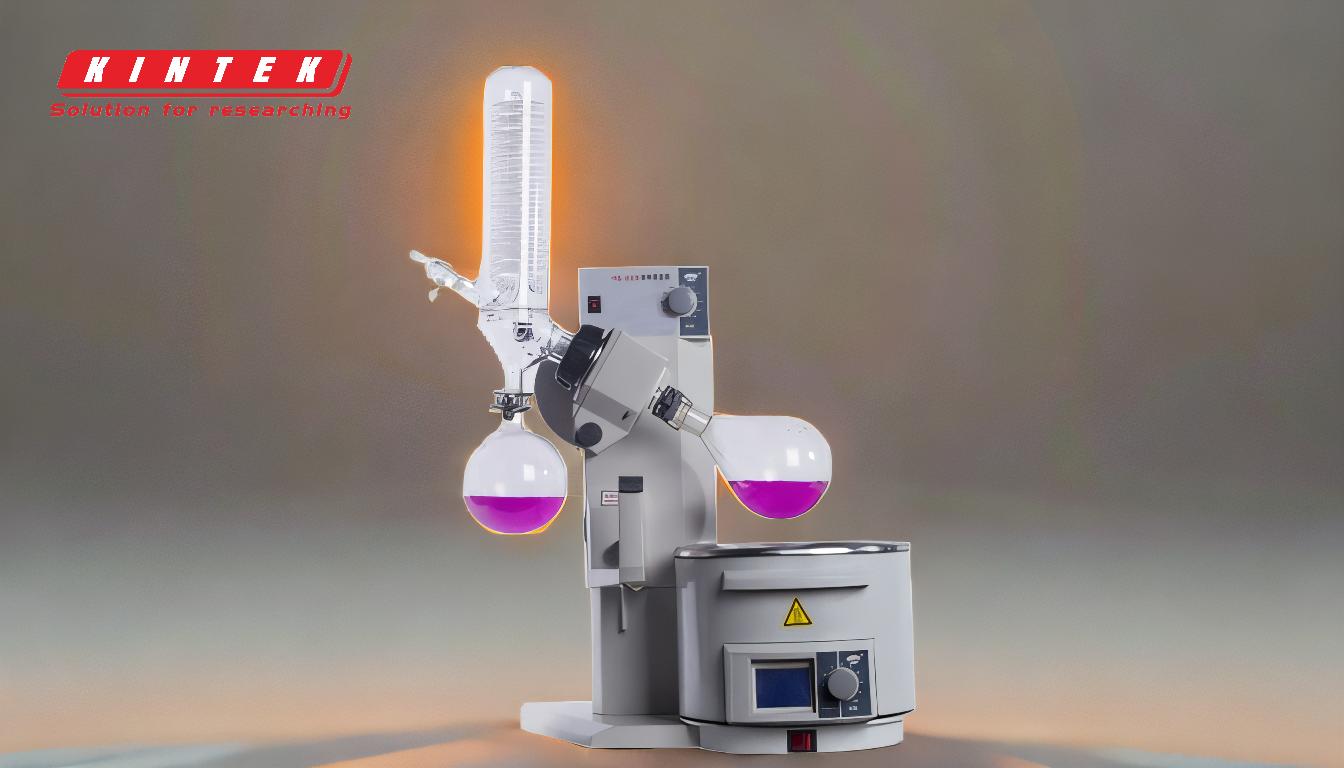Rotary evaporation and distillation are both techniques used to separate and purify compounds, but they differ significantly in their methods, applications, and outcomes. Rotary evaporation is a gentler process that uses reduced pressure (vacuum) to lower the boiling point of solvents, allowing for the removal of solvents without exposing the sample to high temperatures. This method is particularly useful for preserving heat-sensitive compounds and retaining the concentrated residue in the original flask. In contrast, traditional distillation focuses on separating components based on their boiling points, typically retaining the distillate (the condensed vapor) and is often used to concentrate alcohol or remove contaminants. Rotary evaporation is more efficient for solvent removal and is widely used in industries like food, pharmaceuticals, and chemistry due to its ability to preserve the integrity of delicate compounds.
Key Points Explained:

-
Retention of Components:
- Rotary Evaporation: The concentrated residue (the compound of interest) is retained in the original flask after the solvent is removed. This is ideal for applications where the goal is to isolate and preserve the concentrated compound.
- Distillation: The distillate (the condensed vapor) is retained, which is useful when the goal is to collect a purified solvent or concentrate a specific component, such as alcohol.
-
Operating Conditions:
- Rotary Evaporation: Operates under reduced pressure (vacuum), which lowers the boiling point of the solvent. This allows for gentle evaporation at lower temperatures, minimizing the risk of thermal degradation or oxidation of heat-sensitive compounds.
- Distillation: Typically operates at atmospheric pressure or under slight vacuum, relying on the differences in boiling points of the components. This often requires higher temperatures, which can alter or degrade sensitive compounds.
-
Mechanism of Separation:
- Rotary Evaporation: The solvent is evaporated under vacuum, and the rotation of the flask increases the surface area of the liquid, promoting faster and more even evaporation. This method is efficient for removing low-boiling solvents.
- Distillation: Separation occurs through heating and condensation. The mixture is heated to vaporize the components, which are then condensed back into liquid form in a separate container.
-
Applications:
- Rotary Evaporation: Commonly used in industries like food, pharmaceuticals, and chemistry for isolating and concentrating delicate compounds, such as flavors, fragrances, and active pharmaceutical ingredients (APIs). It is particularly useful for preserving the integrity of heat-sensitive materials.
- Distillation: Widely used in industries like alcohol production, petroleum refining, and chemical manufacturing for separating and purifying components based on their boiling points. It is also used for removing contaminants or concentrating specific substances.
-
Efficiency and Speed:
- Rotary Evaporation: Faster and more efficient for solvent removal due to the combination of reduced pressure and increased surface area from flask rotation. This method is well-suited for processing large volumes of solvents.
- Distillation: Can be slower and less efficient for solvent removal, especially when dealing with compounds that have similar boiling points or require precise temperature control.
-
Equipment Design:
- Rotary Evaporation: Uses a rotating flask, vacuum pump, condenser, and collection flask. The rotating flask ensures uniform heating and evaporation, while the vacuum pump reduces pressure to lower the boiling point.
- Distillation: Typically involves a distillation flask, condenser, and receiver flask. The setup may include additional components like fractionating columns for more precise separation of components with close boiling points.
-
Preservation of Compounds:
- Rotary Evaporation: Better suited for preserving the integrity of heat-sensitive or volatile compounds, as it avoids high temperatures and minimizes oxidation.
- Distillation: May alter or degrade sensitive compounds due to the higher temperatures required, especially in traditional setups.
In summary, rotary evaporation and distillation serve different purposes and are chosen based on the specific needs of the application. Rotary evaporation excels in preserving delicate compounds and efficiently removing solvents under reduced pressure, while distillation is more suited for separating and purifying components based on their boiling points. Understanding these differences helps in selecting the appropriate method for a given task.
Summary Table:
| Aspect | Rotary Evaporation | Distillation |
|---|---|---|
| Retention of Components | Concentrated residue retained in the original flask | Distillate (condensed vapor) retained |
| Operating Conditions | Reduced pressure (vacuum), lower temperatures | Atmospheric or slight vacuum, higher temperatures |
| Mechanism of Separation | Evaporation under vacuum with flask rotation | Heating and condensation |
| Applications | Food, pharmaceuticals, chemistry (heat-sensitive compounds) | Alcohol production, petroleum refining, chemical manufacturing |
| Efficiency and Speed | Faster and more efficient for solvent removal | Slower and less efficient for solvent removal |
| Equipment Design | Rotating flask, vacuum pump, condenser, collection flask | Distillation flask, condenser, receiver flask |
| Preservation of Compounds | Preserves heat-sensitive or volatile compounds | May alter or degrade sensitive compounds |
Need help choosing the right separation technique? Contact our experts today for tailored advice!










